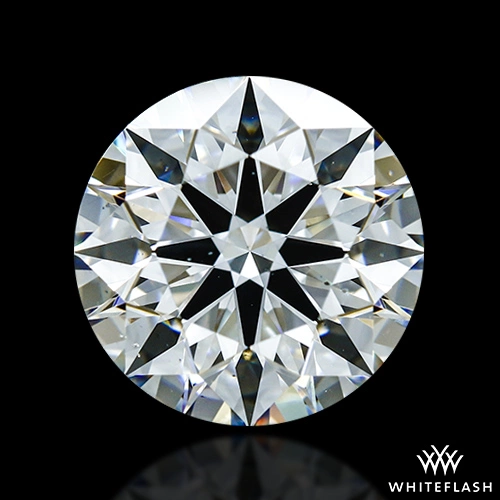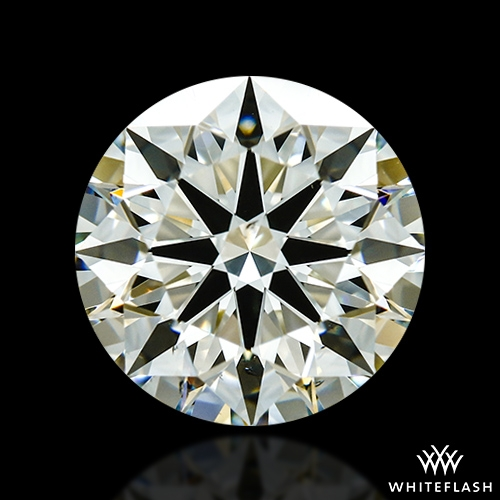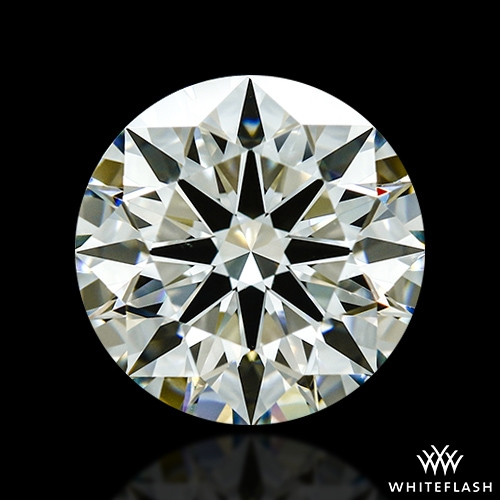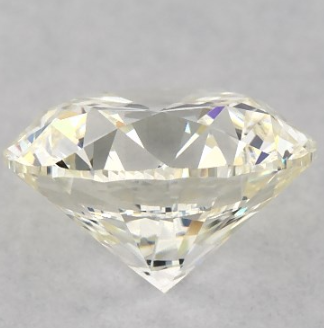This article has mentions of products from one or more companies, and I may receive compensation if you purchase those products following reading my recommendations.
K-color diamonds—they’re not the most popular color, and certainly not the highest on the color scale, but they can still be pretty impressive diamonds if you can find the right example. Even with a slight yellow hue to the diamond, if you pair it with a white gold setting, such as a solitaire engagement ring, it can be just as beautiful as diamonds with high color grading.
Essentially, there are ways and means of combating the slight tint you’ll find in K-color diamonds, which results in you getting a less expensive diamond with impressive qualities similar to its more expensive counterparts.
For example, compare this 1.00 carat K color diamond with this 1.00 carat D color diamond. They’re both the same size, both the same cut quality, and both the same clarity grading, having been graded at a high VVS2. However, the former is $3,747 and the latter is a much more expensive $8,695. So, in this scenario, by changing one little factor such as color grading, you’ve saved around $5,000.
So how do you buy a K-color diamond? What do you need to know before buying? I’ve created this handy article to answer all your questions.
- What Are K-Color Diamonds?
- How Much do K-Color Diamonds Cost?
- Can You Use K-Color Diamonds in Engagement Rings?
- How to Choose a K-Color Diamond
What Are K-Color Diamonds?
A K-color diamond sits at the lower end of the GIA diamond color scale, which you can see below. Diamond color itself is a compelling influence on the price point of a diamond, with colorless diamonds being the most desirable. As you can see, a K-color diamond sits in the ‘faint’ portion of both the GIA and the AGS color scale, which means you can see the faintest yellow tint to the stone in question.

This is obviously not the worst color grade, as there are several below it, but it is usually the lowest color grade that reputable diamond retailers will sell. Furthermore, a K tint is usually only noticeable if the diamond is placed against a white background, which will be rare if it’s used in a diamond engagement ring setting and worn on the finger.

A K color VVS1 diamond from James Allen. As you can tell, the yellow tint is slightly noticeable, but not extremely apparent. Image credit: James Allen
If you’re clever, steps can be taken to reduce even further how noticeable the tint is, and this will end up saving you money in the long run. However, there can also be downsides to purchasing K-color diamonds, which we also cover later on.
How Much do K-Color Diamonds Cost?
Like with any diamond, there’s no one cost-fits-all approach. The price of a diamond is influenced by a multitude of factors, from size to clarity to rarity and many more. Color is one of these, with diamonds in the colorless range (D to F) being generally priced much higher than Ks and other diamonds in the nearly colorless range. So how much can color affect price? I’ll take you through a comparison.
Here are two diamonds by Whiteflash. The first is a 1.024 ct F VS2 A CUT ABOVE® Hearts and Arrows Diamond, a really beautiful example of what a diamond should look like (if you don’t believe me, just watch the video Whiteflash include that shows the diamond’s brilliance).

Image credit: Whiteflash
The second diamond has exactly the same characteristics—1.023 ct VS2 A CUT ABOVE® Hearts and Arrows Diamond in an Ideal cut. The only difference is the color grading, as this diamond is a K.

Image credit: Whiteflash
So what’s the price difference between these two? The first diamond is priced at $9,999.00, and the latter is priced at $5,075.00. That’s a difference of nearly $5,000 dollars—a percentage decrease of 49.2%.
Let’s compare the K color diamond with another, a diamond with the same characteristics but is graded one grade up from K. This 1.028 ct J VS2 A CUT ABOVE® Hearts and Arrows Diamond is slightly larger than the 1.023 ct K VS2, and it is one color grade higher.

Image credit: Whiteflash
The price difference between these two diamonds is smaller, but it’s still significant. If you were to purchase the J color diamond, it is 19% more expensive than the K color diamond. So as you can see, diamond prices are heavily influenced by the color grading they receive.
Can You Use K-Color Diamonds in Engagement Rings?
Yellow tints in diamonds are more noticeable based on a number of factors. The first is the angle at which the diamond is seen. Seen from the top down (the table view), yellow color is hardest to spot—especially when embedded in a high-quality setting. Seen from the side, it’s more apparent.
 |  |
These two images are of the same diamond, this K-color 1.00 Carat Round Diamond from James Allen. The yellow tint is much more apparent from the side view. Image credit: James Allen
Settings will also alter how color can be perceived. Diamonds will reflect some of the color of their settings, so I would recommend you purchase either a white gold or platinum setting if you’re buying a K-color diamond. This will help reduce the amount of noticeable yellow is in the diamond. Conversely, yellow or rose gold may increase the likelihood of noticing the yellow.
How to Choose a K-Color Diamond
As you can tell, K-color diamonds can still be a good choice to purchase, seen as how they can save you a lot of money at the end of your purchasing process. So how do you go about buying one? I’d recommend a focus on three of the Four Cs—Cut, Clarity, and Carat.
Cut
The quality of the cut is potentially the most important feature of a diamond, as it is the thing that most affects light performance. A diamond can have a poor color and poor clarity but still offer good light return if the cut is excellent. And when you find a colorless, flawless diamond with an excellent cut? The results are stunning. When it comes to cut, I’d recommend you always opt for a diamond with either an Excellent or Ideal cut.
Clarity
Over everything else, a diamond must be eye-clean. This means you can see no internal flaws, such as black carbon spots or feathering. Anything VS1 or above will be naturally eye-clean, but you can find eye-clean diamonds at lower clarity grades, such as SI1 (but it can be harder to find them).
Carat
Ultimately, the size and weight choice of the diamond you choose is subjective, but remember that the larger the diamond, the more it will cost. For items such as engagement rings, diamonds that sit around 1.00 ctw are the perfect size. When comparing diamonds, try and find a variety that sit around the same size, which is an easy metric for you to control.
My Final Thoughts
K-color diamonds can be decent, but you have to really look hard at the other characteristics to ensure you’ve found a good one. The key is having a very high cut quality, such as Ideal or Excellent.
When trying to buy any diamond, my best bit of advice is: do your research. With more knowledge regarding these precious gemstones, you’re more likely to find a good deal and end up with something truly special. You can visit our blog or diamond education section for the information you need.
